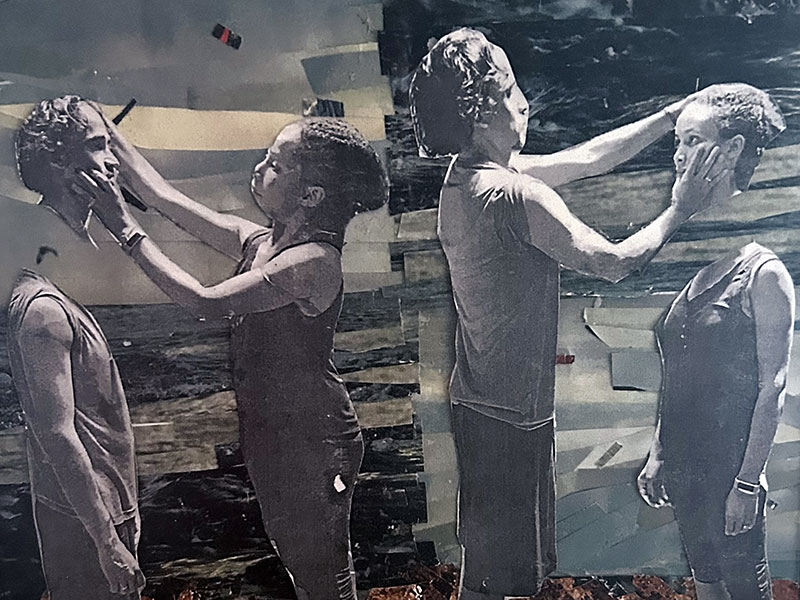
Q:How long have you been a members? Why did you join RoCo?
A Erica: I don’t actually know… many years. I joined because RoCo is a place to see the unexpected. You walk into the gallery and there’s a 16-foot dandelion. An ocular headset allows you to enter another person’s dream about flying cows. RoCo offers a respite from the monotony and horror of regular life. Sometimes, to be sure, the artwork focuses on the horrors of regular life -- police brutality, racism, environmental degradation-- but I feel like these works usually ask us to imagine a better world.
A Rajesh: I joined RoCo nearly 10 years ago, during the Question Bridge: Black Males exhibit in November of 2014. I joined RoCo pretty simply because I kept frequenting exhibits here more than any other creative gallery in Rochester. The consistent promotion of experimental art and works from marginalized communities attracted me to this space over and over.
Q: What is your favorite exhibition that you’ve seen at RoCo?
A Erica: The annual member exhibitions. There’s such a variety of art from a variety of people who are all dancing at different spots along their artistic journey. I love the democracy of it and you are always going to see something amazing. Last year a piece from Julie Chen called “I Can’t Forget, Okay?” just blew a hole through my heart. It was a multimedia artwork made from a voicemail from her mother and some of her mother’s ashes. It was really beautiful and just captured the best and hardest parts of being human.
A Rajesh: My favorite exhibit was the FUA Krew exhibit way back in 2009 for the State of the City exhibit. This was the first time, to my knowledge, graffiti had been allowed to enter an official indoor gallery space in Rochester.
Q: If you could learn a new skill, what would it be?
A Erica: To juggle flaming pins. I am actually working on that, so stay tuned.
A Rajesh: I would like to learn how to draw better so I could make cartoons, either that or play the drums for some kind of rock band. John Kastner would be that artist! I don’t know him, somehow he is in my FB feed, he is a Rochesterian! I like his style, it is wild.
Q: If you could own any piece of art, which would it be?
A Erica: The Burning Giraffe by Salvador Dali. I grew up with conservative parents who liked conservative art. Lots of realistic paintings of flowers and people praying in our house. When I saw Dali’s painting of this giraffe, who was on fire, but not suffering, behind a woman with all these drawers in her leg who was holding aloft bloody glob, it was like seeing color for the first time.
A Rajesh: I don’t believe in ownership, so I am not trying to collect art, so I can’t even think in those terms. Next question!
Q: What is great about Rochester? What can we do better?
A Erica: The people! I also sort of like the weather because I think it makes you tough. I am very proud of having been born in a mid-April snowstorm. When you are walking the dark snowy winter solstice hellscape, with all the dead-looking trees it’s like being on another planet.I love when the weather finally breaks and kids come streaming outside like rats off a ship. Everyone is so happy. As for what we can do better, I’d say the same things as I would for every place in the world. Eradicate violence and poverty, respect the natural environment, ensure that everyone has the fair chance to chase their dreams.
A Rajesh: Rochester is amazing because it is not yet written, it has a shape-shifting identity. You don’t know what it is going to be from one day to the next. One day it is “smugtown” the next it is the backdrop of world changing revolutionary spirits. We could do better by not trying to look outward to find ourselves, not trying to be other cities, and really study who our community has been, is currently and where they want to go, not what some stodgy real-estate moguls want Rochester to be.
Q: What do you believe is the role of artists in fighting for social justice and human rights?
A Erica: To achieve social justice and human rights for all, and end mass incarceration, and other forms of oppression, people need to be able to work outside of reality, which is not easy to do. I think that artists get people to exercise the muscle of imagination and to believe that the unreal can be made real. To create a world with justice and resources for all, you need a willingness to reject the boundaries of what’s “realistic” and escape the prison of the “real” world. Artists do this all the time.
A Rajesh: On the one hand, the role of artists is to slow the world down and bring the rhythms of human nature back in sync with their natural surroundings. On the other hand, artists have to know when, be aware, and at critical moments put down the brush, and/or camera, and join in the fray with political artists a.k.a. activists ready to swarm on and outnumber the tyrannical forces.

